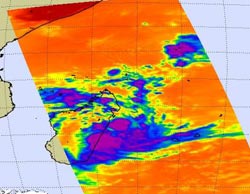Low strengthens into Hubert, making landfall in Madagascar

NASA\'s Aqua satellite captured cold thunderstorm cloud tops of Hubert in this infrared image of March 10 at 5:11 a.m. ET. Hubert\'s western edge is already raining on Madagascar. Credit: NASA JPL, Ed Olsen<br>
The Atmospheric Infrared Sounder (AIRS) instrument on NASA's Aqua satellite captured Tropical Storm Hubert's cold thunderstorm cloud tops on March 10 at 5:11 a.m. ET as the western edge of the storm was already raining on eastern Madagascar.
The infrared imagery showed two areas where convection was strong in Hubert: the northeastern and southern quadrants of the storm. It is in those two areas that the highest, coldest thunderstorm tops were revealed by AIRS infrared imagery. Those thunderstorm cloud tops were as cold as -63 Fahrenheit!
Hubert has maximum sustained winds near 39 mph (35 knots) and is moving west-southwest near 6 mph (5 knots). At 10 a.m. ET (1500 UTC) on March 10, Hubert was located about 160 nautical miles southeast of the capital city of Antananarivo, Madagascar near 20.9 South and 48.8 East.
As Hubert continues moving inland over the next two days, forecasts for the capital city and other areas in south central Madagascar will continue to experience periods of moderate to heavy rainfall, and gusty winds.
Animated multispectral satellite imagery showed a loss of central convection as Hubert's center moves closer to a landfall. Once Hubert's center is over land, forecasters expect Hubert will quickly fall below tropical storm strength.
Media Contact
More Information:
http://www.nasa.govAll latest news from the category: Earth Sciences
Earth Sciences (also referred to as Geosciences), which deals with basic issues surrounding our planet, plays a vital role in the area of energy and raw materials supply.
Earth Sciences comprises subjects such as geology, geography, geological informatics, paleontology, mineralogy, petrography, crystallography, geophysics, geodesy, glaciology, cartography, photogrammetry, meteorology and seismology, early-warning systems, earthquake research and polar research.
Newest articles

Properties of new materials for microchips
… can now be measured well. Reseachers of Delft University of Technology demonstrated measuring performance properties of ultrathin silicon membranes. Making ever smaller and more powerful chips requires new ultrathin…

Floating solar’s potential
… to support sustainable development by addressing climate, water, and energy goals holistically. A new study published this week in Nature Energy raises the potential for floating solar photovoltaics (FPV)…

Skyrmions move at record speeds
… a step towards the computing of the future. An international research team led by scientists from the CNRS1 has discovered that the magnetic nanobubbles2 known as skyrmions can be…




















